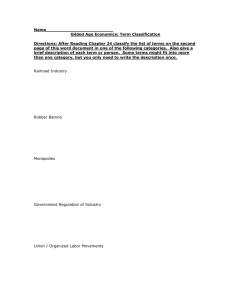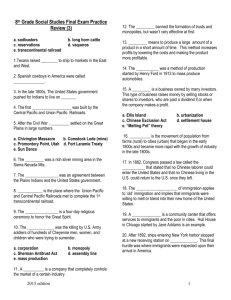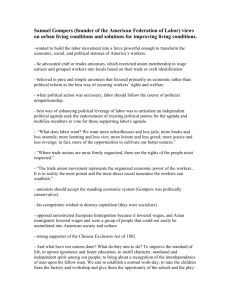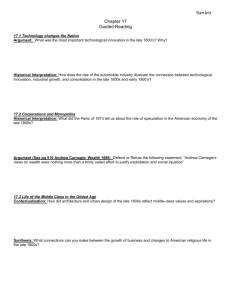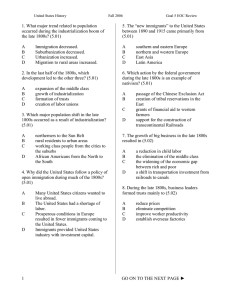Industrialization
advertisement
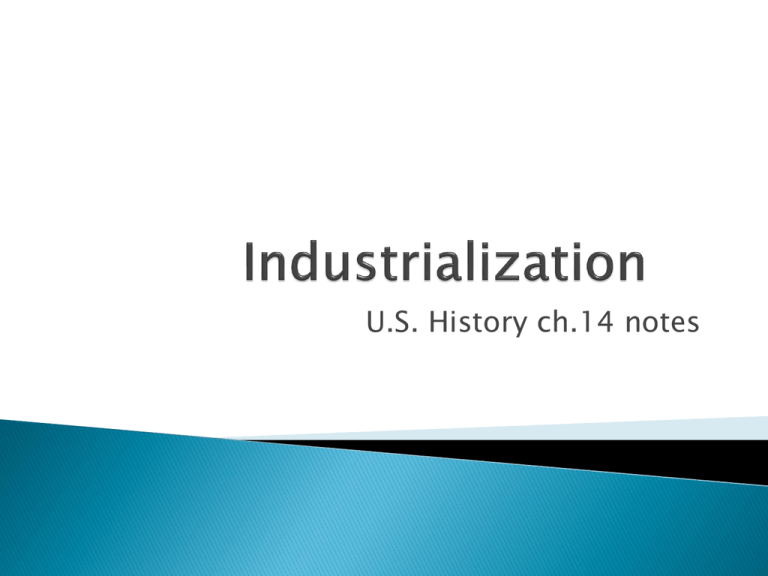
U.S. History ch.14 notes Out of population of 30 million, only 1.3 million worked in industry in 1860 After the Civil War, industry rapidly expanded, & millions of Americans left their farms to work in mines and factories. By the early 1900s, Americans had transformed the U.S. into the world’s leading industrial nation. The U.S. contained vast natural resources upon which industry in the 1800s depended, including water, timber, coal, iron, and copper. Many of the nation’s resources were located in the mountains of the American West. The settlement of this region after the Civil War helped to accelerate industrialization. RR’s brought settlers and miners to the West, & carried resources back to factories in the E. Even before the invention of the automobile, petroleum was in high demand b/c it could be turned into kerosene, which was used in lanterns and stoves. In 1859 Edwin Drake drilled the first oil well near Titusville, PA. By 1900 oil fields from PA to TX had been opened. As oil production rose, it fueled economic expansion. Between 1860 and 1910, the population of the U.S. almost tripled. This population provided industry with a large workforce & also created greater demand for the consumer goods that factories produced. Population growth stemmed from large families and a flood of immigrants. B/W 1870 & 1910, roughly 20 million immigrants arrived in the U.S. Free Enterprise allowed the U.S. to industrialize rapidly. Americans embraced the idea of laissez-faire, literally “let do,” a French phrase meaning “let people do as they choose.” Supporters of laissez-faire believe the gov’t shouldn’t interfere in the economy other than to protect private property rights and maintain peace. New inventions led to the founding of new corporations, which produced new wealth and new jobs. One of the most important inventions was the telephone invented by a young Scottish inventor named Alexander Graham Bell. The most famous inventor of the late 1800s was Thomas Edison. In 1889 several Edison electric companies merged to form the Edison General Electric Company (Known today as GE). In 1865 the U.S. had about 35000 miles of RR track, almost all of it E of the Miss. River. After the Civil War, RR construction expanded dramatically, linking the distant regions of the nation in a transportation network. By 1900 the U.S. had over 200,000 miles of RR track. The RR boom began in 1862 when President Abraham Lincoln signed the Pacific Railway Act, which provided for a transcontinental RR. Under Grenville Dodge the Union Pacific began pushing westward from Omaha, NB in 1865. At the height of the project, the Union Pacific employed about 10,000 workers. Workers included Civil War veterans, new immigrants from Ireland, frustrated miners & farmers, and ex-convicts. The Central Pacific began in California and pushed eastward to meet the Union Pacific. The two railways came to a meeting at Promontory Point, UT forming the Transcontinental RR. The Central Pacific used somewhere around 10,000 Chinese immigrants as its major source of labor for the railway project. To encourage RR construction the federal gov’t gave states land, which the states in turn sold to settlers, real estate companies, and other businesses to raise the money they needed to build the RR. During the 1850s and 60s, the federal land grant system awarded RR companies over 120 millions acres of land. The great wealth many RR entrepreneurs gained in the late 1800s led to accusations that they had built their fortunes by swindling investors and taxpayers, bribing gov’t officials, and cheating on their contracts and debts. The person with the worst reputation for this kind of activity was Jay Gould, who often practiced “insider trading.” Before the Civil War small businesses dominated the American economy, but by 1900 big businesses were the greatest force in the American economy. Big businesses wouldn’t have been possible without the corporation. A corporation is an organization owned by many people, but treated like an individual in regards to the law. The small manufacturing companies that had been typical before the Civil War had very low fixed costs but very high operating costs. Big businesses that developed after the Civil War had high fixed costs but low operating costs. Many corporate leaders didn’t like the competition caused by falling prices, so they formed organized pools, or agreements to maintain prices at a certain level. American courts and legislators were suspicious of pools because they interfered with competition. In 1882 Standard Oil formed the first trust. A trust is a legal concept that allows a person to manage another person’s property. Instead of buying a company outright, Standard Oil had stockholders give their stocks to a group of Standard Oil trustees. In exchange the stockholders received shares in the trust. There were two basic types of industrial workers in the U.S. in the 1800s – craft workers and common laborers. Craft workers had special skills and training. They included machinists, iron molders, stonecutters, shoemakers, printers, etc… Craft workers generally received higher wages while common laborers received lower wages and had less skills. In the mid 1800s as industrialism began to spread craft workers began to organize trade unions limited to people with specific skills. By 1873 there were 32 national trade unions in the U.S. Although workers often attempted to create large unions, they rarely succeeded. In many cases the confrontations b/w workers, owners, and gov’t led to violence and bloodshed. In 1873 a severe recession known as the Panic of 1873 forced many American companies to cut wages. This triggered the first nationwide labor protest. By the late 1870s enough workers had joined the Knights of Labor that it became America’s first nationwide industrial union. The Knights called for an 8 hr. work day, equal pay for women, the abolition of child labor, and the creation of worker-owned factories. The riot took place during early May of 1886 in Chicago, IL when workers staged a strike in order to get an eight-hour work day. A clash broke out between strikers and police and left one striker dead. In response to the killing an anarchist group organized a protest meeting in Chicago’s Haymarket Square. The protest got violent when police and workers clashed yet again. 7 police officers and 4 workers were killed in what became known as The Haymarket Riot. In 1886 delegates from over 20 of America’s trade unions organized the American Federation of Labor (AFL). The AFL’s first leader was Samuel Gompers. Gompers believed that unions should stay out of politics and he rejected socialist and communist ideas.
